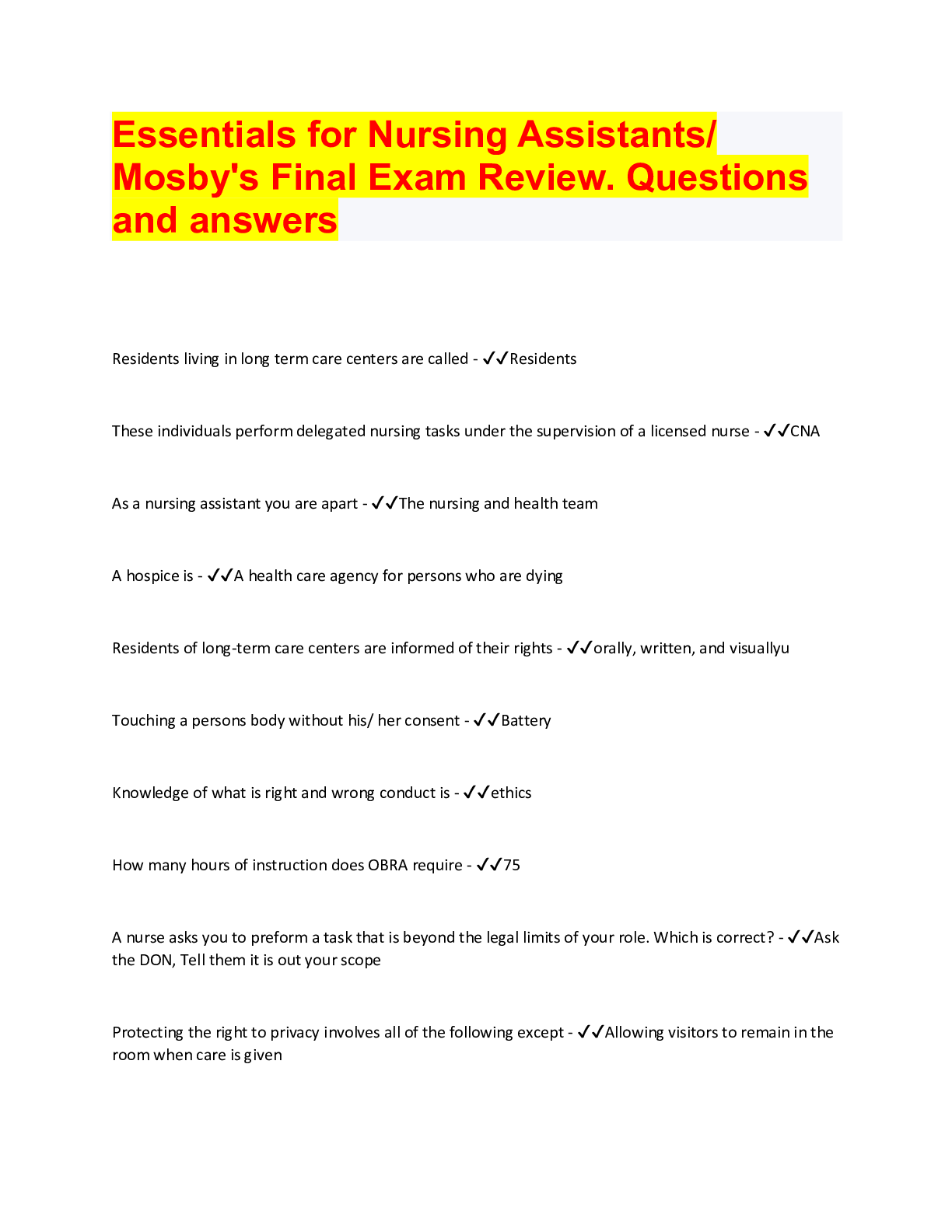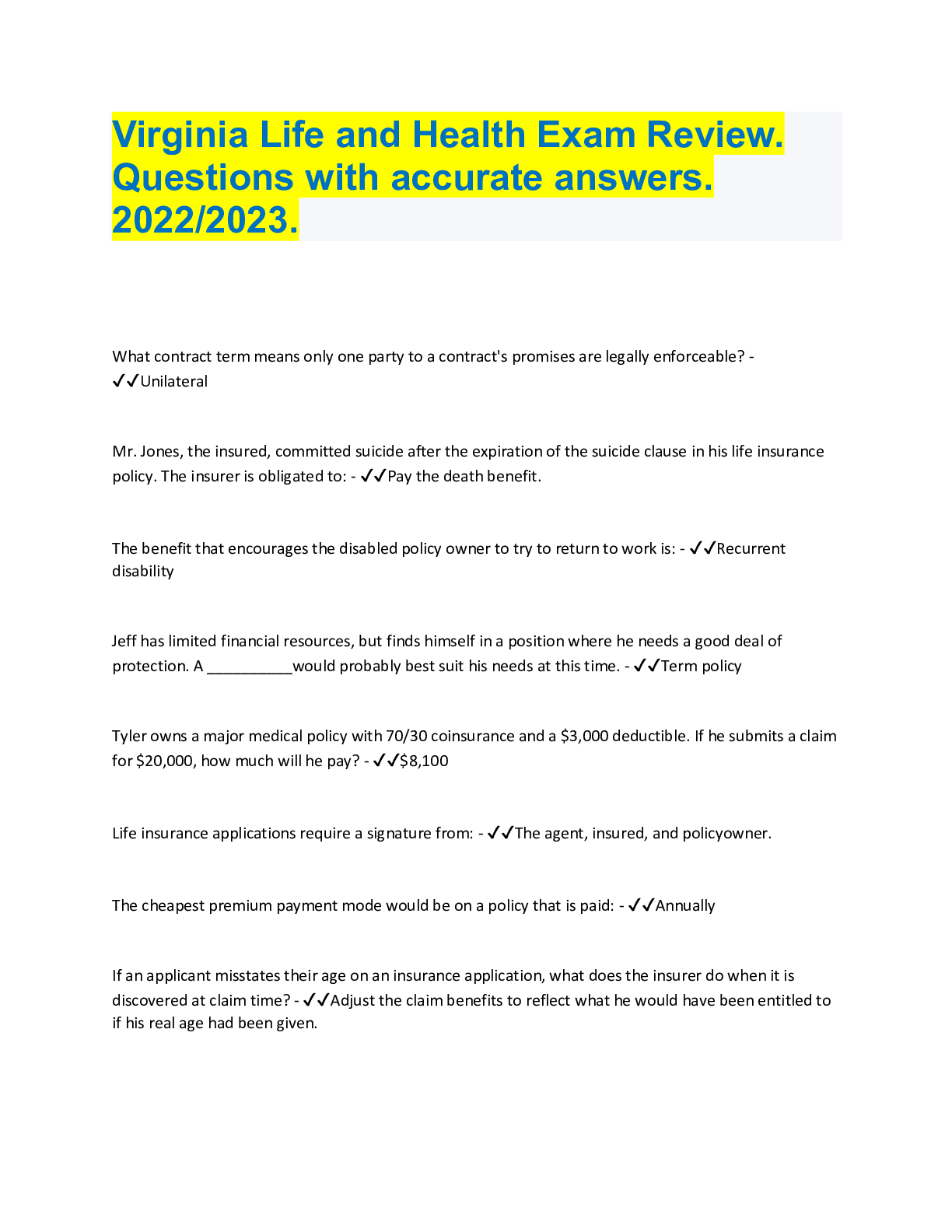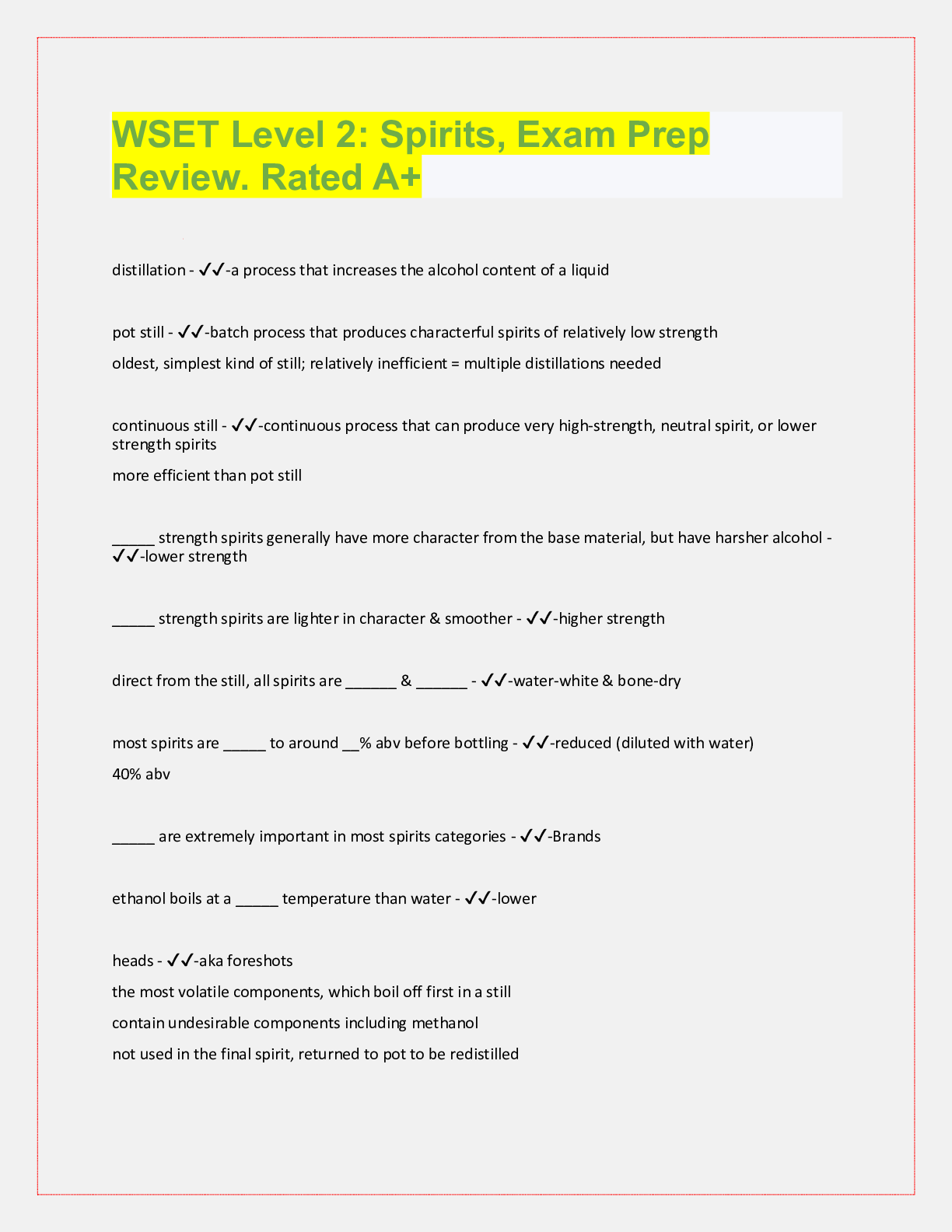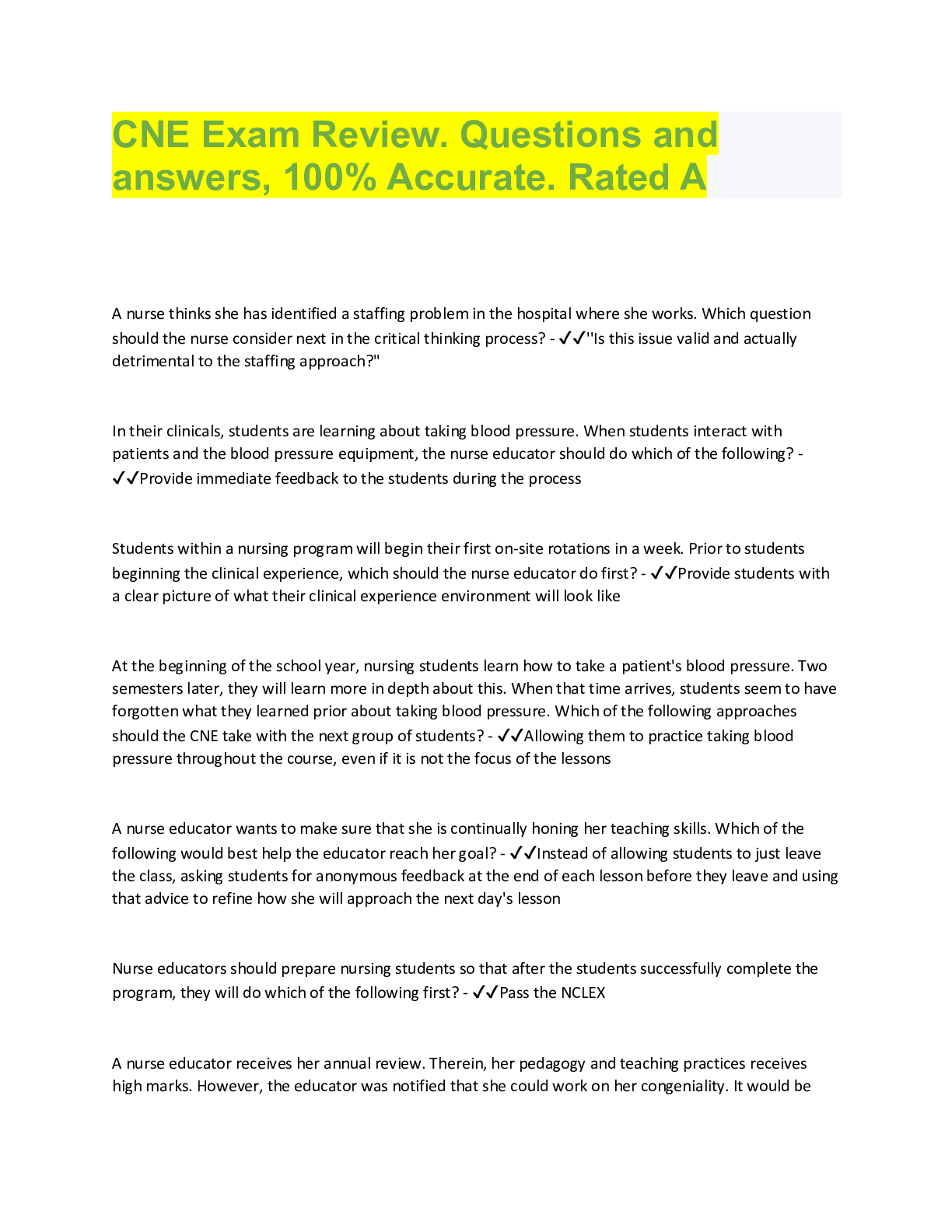Social Sciences > QUESTIONS & ANSWERS > LCSW + Exam Review. Questions prep Review. Rated A+ Pilot study - ✔✔-a (All)
LCSW + Exam Review. Questions prep Review. Rated A+ Pilot study - ✔✔-a
Document Content and Description Below
LCSW + Exam Review. Questions prep Review. Rated A+ Pilot study - ✔✔-a procedure testing and validating a questionnaire or other instrument by administering it to a small group of respondents... from the intended test population; the procedure helps determine whether the test items possess the desired qualities of measurement and the ability to discriminate other prob- lems before the instrument is put to widespread use. Null hypothesis - ✔✔-the statement that no relationship exists Experimental group - ✔✔-in research a collection of subjects who are matched and compared with a control group in all relevant respects, except that they are also subject to a specific variable being tested. Correlation - ✔✔-a mutual relation a pattern of variation be- tween two phenomena in which change in one is associated with change in the other. Mean - ✔✔-the average value or measure of central ten- dency. Literature review - ✔✔-the process of searching published work to find out what is known about a research topic. physical indicators of abuse - ✔✔-history of multiple injuries, history doesn'tfit, bruises on abdomen and genital, linear bruises, bruises on neck, bitemarks burn head injuries and skull fractures. Indicators of neglect - ✔✔-SELF stimulatory behavior, developmental delay, failure tothrive, poor weight gain, thin extremities, hoarding or stealing food, chronictiredness and drowsiness, falling asleep in school. Or attempts to comfortthemselves through masturbation. Awkward peer relationships. Behavioral and emotional indicators of abuse - ✔✔-a child who is remote withdrawn, detached andunresponsive, ambivalent, regressive behavior, frozen watchfulness, hyperactive behavior, lying, stealing, fighting, angry outburst, anxiety, depression, dissociation episodes Sign of sexual abuse - ✔✔-- marked change in child's behavior, bedwetting, soiling the bed, falling asleep in class, highly sexualized behavior, gripping in public. Child neglect - ✔✔-the failure of those responsible for the care of a minor to provide the resources needed for healthy physical emotional and social development. Child abuse - ✔✔-physical or emotional injury on a dependent minor through intentional beating uncontrolled corporal punishment persistent ridicule and degradation. Physical indicators of abuse - ✔✔-history of multiple injuries, history doesn't fit, bruises on abdomen, and genitals, linear bruises, bruises on neck, bite marks and burns, head injuries and skull fractures. Elder abuse - ✔✔-mistreatment of older people and relatively dependent people including physical battering neglect financial or other exploitation and psychological harm Physical abuse and neglect - ✔✔-bruises, welts, lacerations, punctures, burns, head injuries, weight loss, untreated medical conditions and restraining the person, Psychological abuse and neglect - ✔✔-sleep disturbance, change in eating patterns, unexplained weight changes, depression and crying, low self-esteem, fearfulness and paranoia, confusion and disorientation, apathy and agitation, social isolation and self-neglect. Financial abuse - ✔✔-lack of food complaints of hunger, inability to pay bills, over involvement of family members in financial affairs refusal to pay for services unexplained withdrawals from bank account crisis - ✔✔-overwhelming event that upsets one's psychological equilibrium or baseline of functioning. Maturational crises - ✔✔-precipitated by normal stress during the course of life. Example, marriage, child birth retirement Situational crises - ✔✔-precipitated by sudden traumatic event. Example, death of a loved one, loss of job and illness Crises intervention - ✔✔-1-6 weeks' sessions during period of crisis, supportive focused therapy. low risk - ✔✔-limited thoughts of harm, no plan or intent, low risk factors present low risk intervention - ✔✔-individual social support, individual coping mechanism, referrals for clinical contacts, establish future events to look forward too, and reassess frequently Moderate risks - ✔✔-ideation with limited plans and no intent moderate risk interventions - ✔✔-explore alternative to violence, remove lethal means to harm, decrease isolation, explore the options of meds. High risks - ✔✔-specific plan with intent, access to lethal weapon, limited support, impaired self-control. defense mechanism - ✔✔-help cope with the anxiety and frustration and unacceptable impulses. Help relieve the tension between inner psych and demands of external world primitive defense mechanisms - ✔✔-are more out of touch with reality for ex: denial, reaction formation and projection Higher levels of functioning - ✔✔-sublimation, undoing, rationalization, displacement, identification and intellectualization Rationalization - ✔✔-plausible reasons to justify an action or a plan. Example- After not getting a job the person will say I'll be better off at another company. After being turned down for a date the person will say they were not my type After person is abused they rationalize by hitting their children as punishment after they were hit by their spouse. Repression - ✔✔-refuses to let in awareness unacceptable impulses but remains unconsciously operative in behavior. Symbolization - ✔✔-a mental representation stands for some other thing, example dreams. Substitution - ✔✔-unattainable goal or emotion that is replaced by more acceptable or attainable one Splitting - ✔✔-associated be personality disorder which sees people as all good or all bad Regression - ✔✔-return to more infantile patterns of reacting or thinking Inhibition - ✔✔-loss of motivation to engage in pleasurable activity Incorporation - ✔✔-parts of a person that are figuratively ingested Idealization - ✔✔-overestimation of an admired aspect or attribute of another Undoing - ✔✔-a process of which we avoid being punished for undesirable thoughts or actions Ex; a person is overly nice to someone they just insulted in her mind A spouse buys his spouse lavish gifts as a way to undo his adulteress acts Sublimation - ✔✔-displace unacceptable instincts for constructive and socially acceptable behaviors. Example: a person with depression may use professional dance to help sublimate suicidal thoughts Denial - ✔✔-distorts reality and does not acknowledge emotion Example: an alcoholic attending recovery but continues to drink Projection - ✔✔-places unacceptable feelings from the person feeling them onto another person. Ex: anxious person complaining that someone else is anxious Someone complaining that they nobody likes him yet doesn't like himself or others Introjection/internalization - ✔✔-is the internalization of outside events or characteristics of other people. Refers to the process of taking it all in or swallowing it whole. Ex: a victim uses identification with the aggressor's behaviors to help protect himself Putting on a seat belt before driving. Intellectualization - ✔✔-process by which content is separated from repressed affect Ex: when someone speaks of their traumatic event like they were reading a script Ex: a person of sexual assault may use intellectualization by researching factual PTSD criteria instead of addressing her emotional pain in therapy. Identification - ✔✔-typically refers to the display of a particular characteristic of trait that has been absorbed into one's own personality. Ex; following in the footsteps of your father's profession. Displacement - ✔✔-a defense mechanism in which affect is transferred from one object to another Compulsively eats lollipops after quitting smoking Compulsively washes hands after being shamed for masturbating Yelling at spouse because you cannot yell at your spouse Piagets theory - ✔✔-people actively construct higher levels of knowledge. Disequilibrium- motivation for cognitive development. Equilibirum- achieved thru assimilation and accommodation which leads to adaptation 4 stages to Paiget theory - ✔✔-Sensorimotor stage, Pre-operational Stage, Concrete Operational Stage, Formal Operational Stage. Sensorimotor stage - ✔✔-From birth to age 2 infants learn three achievements. Object permanence, causality, symbolic thought. Object permanence - ✔✔-at 8 months' child will recognize that object exist even when out of sight Causality - ✔✔-at 10 months' child will recognize it can use its hands to pick up a toy Symbolic thought - ✔✔-at 18 months' child is learning language and uses language symbols to think about actions before performing them Preoperational Stage - ✔✔-ages 2-7 the key characteristic is symbolic functioning which allows a child 2 learn thru the use of mental images. Child will engage in symbolic play Precausal preasoning - ✔✔-limits understanding of cause and effect and is evidenced by magical thinking. Egocentrism - ✔✔-limits perspective to take another person's perspective. Child believe he likes dolls because she likes dolls Irreversibility - ✔✔-child cannot recognize that an action can be done and undone. A child does not recognize that a dish full of water is the same as it is being poured into a beaker. Concrete Operational Stage - ✔✔-ages 7-11- child capable of performing operations using logic and abstract thinking. Seriation - ✔✔-child places block in order by height Classification - ✔✔-child sets block together by color. Decentering - ✔✔-ability to take into account multiple aspects of problem and solve it. Reversibility - ✔✔-learning that actions can be reversed Conservation - ✔✔-learning that quantity and length of an item is unrelated to arrangement and appearance. Formal operational stage - ✔✔-11 to adulthood- increase in thinking about thinking return to egocentiricism. Is able to think more abstractly and hypothetically Trust vs Mistrust - ✔✔-0- 18 months- developing trust between caregiver and infant. Autonomy vs Shame and Doubt - ✔✔-18 months -3- toddler is learning their independence such as walking and exploring. Initiative vs guilt - ✔✔-3-6- learning to carry out goals without infringing on others Industry vs inferiority - ✔✔-6-12- achieve a sense of competence by beginning school and learning to do things. Identity vs role confusion - ✔✔-12-18- learning new roles that will occupy as an adult while developing a sense of self and personal identity Intimacy vs isolation - ✔✔-18-40 -begin to from intimate relationships with other people. Success- comfortable in relationships with a sense of commitment and care Failure- unable to develop intimacy which can lead to isolation and feeling of exclusion. Generativity vs stagnation - ✔✔-40-65 to participate that gives the person a sense of purpose Ego Strength vs. Despair - ✔✔-Despair 65 - death- for older adults to look back on life and feel a sense of fulfillment. Asian Americans - ✔✔-establish credibility as a professional, explain principles of family therapy involve elders in the process. Address somatic complaints Stay focused on the problem Respect family hierarchy Avoid being confrontational Reframe problems into positive terms African American - ✔✔-Recognizes the totality in life experiences in culture Therapist is more disclosing Importance is based on changing environment is not only good for the person but the community Focused place on personal rituals and cultural considerations. Native American - ✔✔-use active listening and reflective responses Do not interrupt client Ask permission to ask about personal matters Avoid excessive note taking or asking to many questions Pay attention to dreams, rituals and experiences Keep promises Accept long periods of silence Greet client with warmth and firm hand shake Client time to adjust to new setting Latino American - ✔✔-use family as a method of treatment Assess acculturation Explore migration immigration experiences Respect father and father figure in family Interview family members individually Discuss family belief and history of behavioral health services Engage family in first meeting with warmth and persoanlismo Alcohol intoxication - ✔✔-aggressive behaviors impaired judgment slurred speech, emotional lability unsteady gait, impaired attention and memory Alcohol signs of withdrawal - ✔✔-sweating tachycardia, hand tremor, insomnia, nausea or vomiting, transient illusions or hallucinations, anxiety grand mal seizures delirium and tremors. Alcohol Wernickes Encephalopathy - ✔✔-caused by thiamine deficiency associated with alcoholism symptoms include confusion, loss of muscle, coordination leg tremors and vision changes, abnormal eye movement double vision eyelid dropping Korsakoffs Syndrome - ✔✔-- amnesia and confabulation memory loss by fabricating memories Amphetamines and Cocaine intoxication - ✔✔-euphoria anxiety hyperactivity, grandiosity, confusion, anger paranoia auditory hallucinations, tachycardia, nausea vomiting weight loss muscular weakness confusion seizures. Caffeine signs of intoxication- - ✔✔-restlessness, nervousness, excitement, insomnia, flushed face, GI issues muscle twitches, rambling, tachycardia Caffeine signs of intoxication - ✔✔-restlessness, nervousness, excitement, insomnia, flushed face, GI issues muscle twitches, rambling tachycardia Hallucinogens signs of intoxication - ✔✔-perceptual changes anxiety depression ideas of reference paranoid ideation palpitations, blurred vision Opioids signs of intoxication - ✔✔-initial euphoria followed by apathy or dysphoria: pupillary constriction drowsiness or coma slurred speech impaired attention Opioids signs of withdrawal - ✔✔-dysphoric mood, nausea or vomiting, muscle aches, runny eyes and nose pupillary dilation, diarrhea, yawning fever and insomnia Alcoholic family dependent - ✔✔-the alcoholic family member Enabler - ✔✔-often the spouse the person who does everything to get the dependent to stop drinking except what might actually work which is confrontation or leaving the person. hero - ✔✔-the oldest child the member who is aware of what is going on and tries to assume the responsibility for the family by being successful scapegoat - ✔✔-the second child the family member who rejects the family lost child - ✔✔-the family member who quietly withdrawals from the family mascot - ✔✔-the youngest child who plays the clown in order to relieve family tension or their own pain Remission - ✔✔-none of the criteria for substance use disorder except cravings are met for at least 3 months but less than 12 months. Unconscious - ✔✔-contains thoughts, feelings, desires, and memories of which clients have no awareness, but that influence every aspect of their day-to day lives. Preconscious - ✔✔-contains all the information outside of a client's attention but that is readily available if needed. Conscious - ✔✔-contains all the information that a client is paying attention to at a given time. Superego - ✔✔-- is the moral component of personality. It causes clients to feel guilty when they go against society's rule [Show More]
Last updated: 2 years ago
Preview 1 out of 41 pages
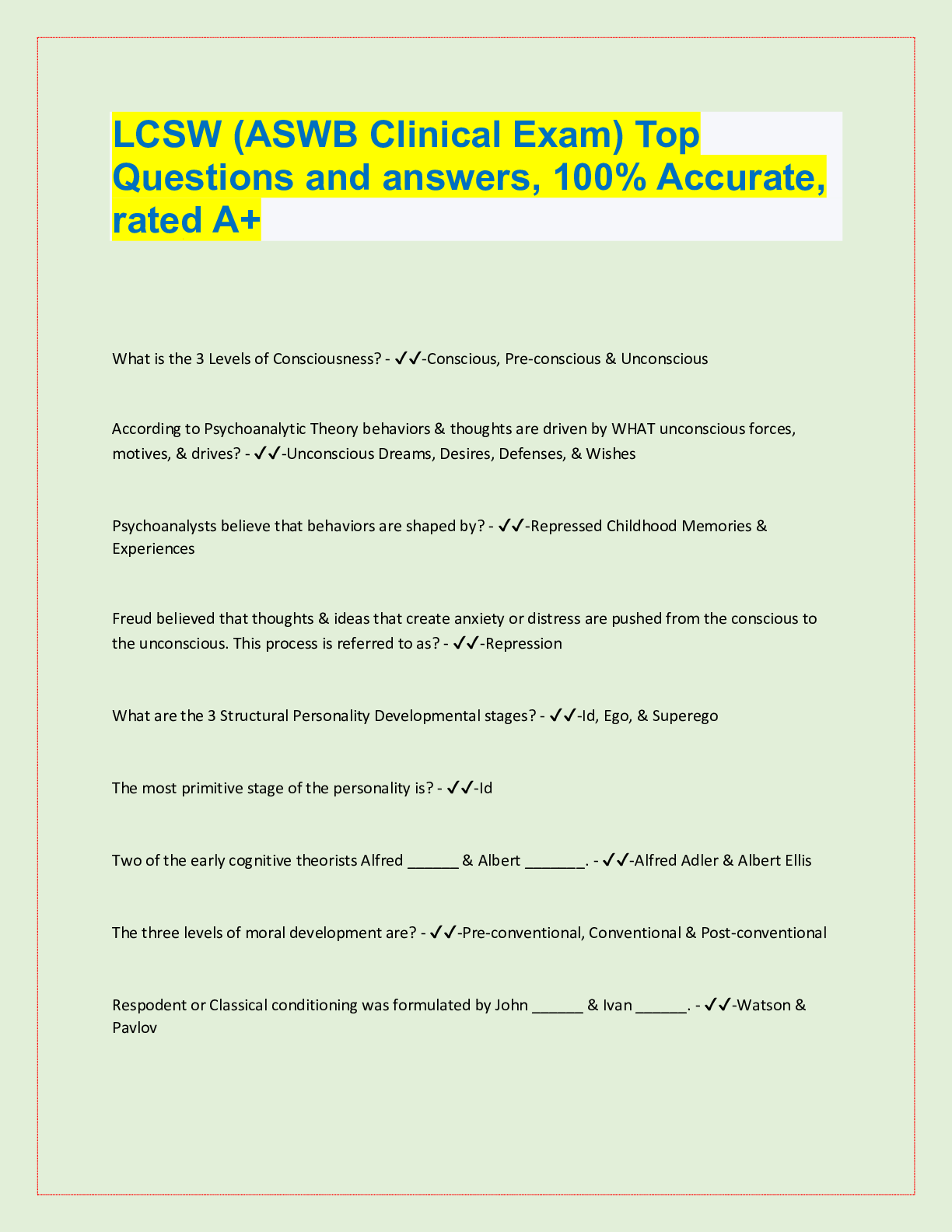
Buy this document to get the full access instantly
Instant Download Access after purchase
Buy NowInstant download
We Accept:

Reviews( 0 )
$13.00
Can't find what you want? Try our AI powered Search
Document information
Connected school, study & course
About the document
Uploaded On
Mar 15, 2023
Number of pages
41
Written in
Additional information
This document has been written for:
Uploaded
Mar 15, 2023
Downloads
0
Views
121

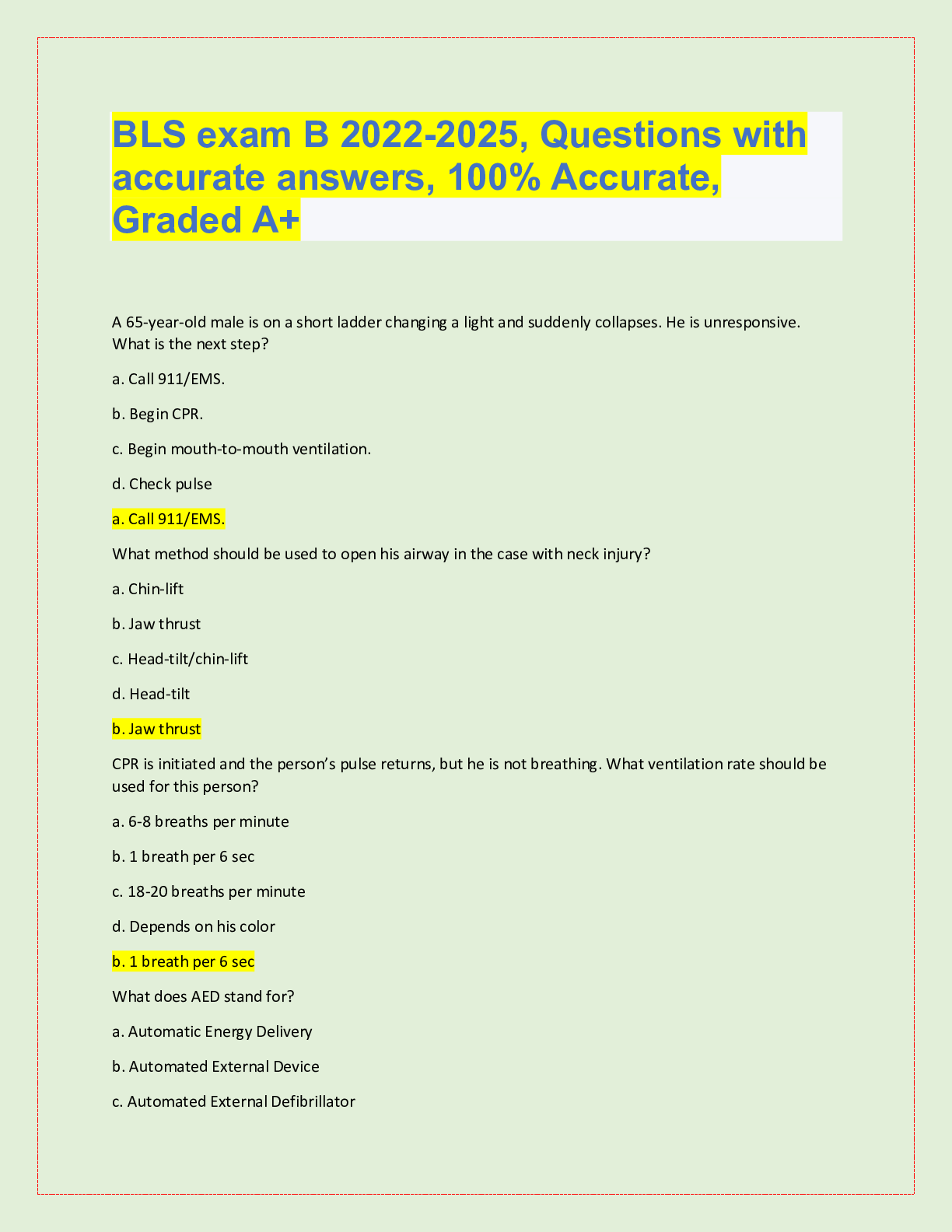











.png)
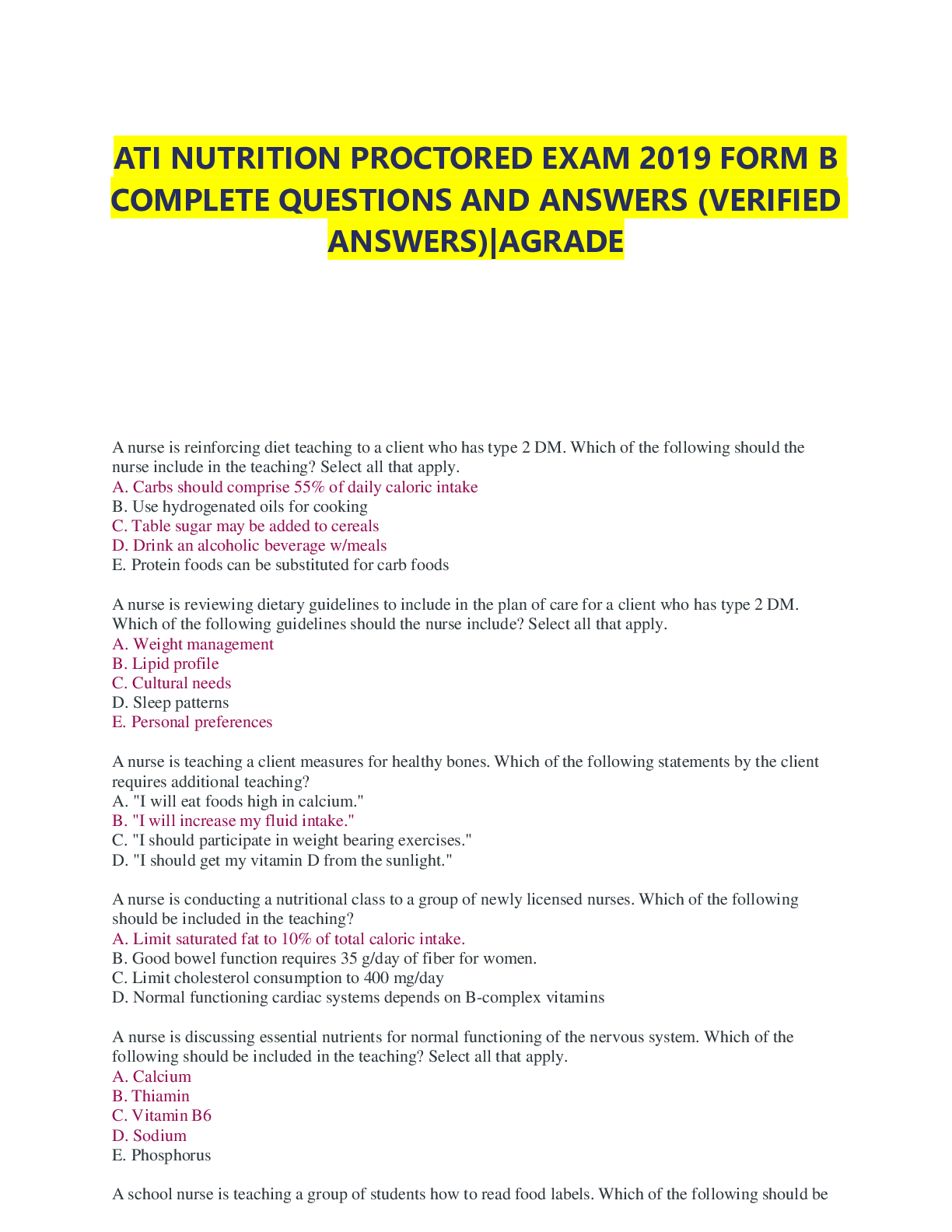

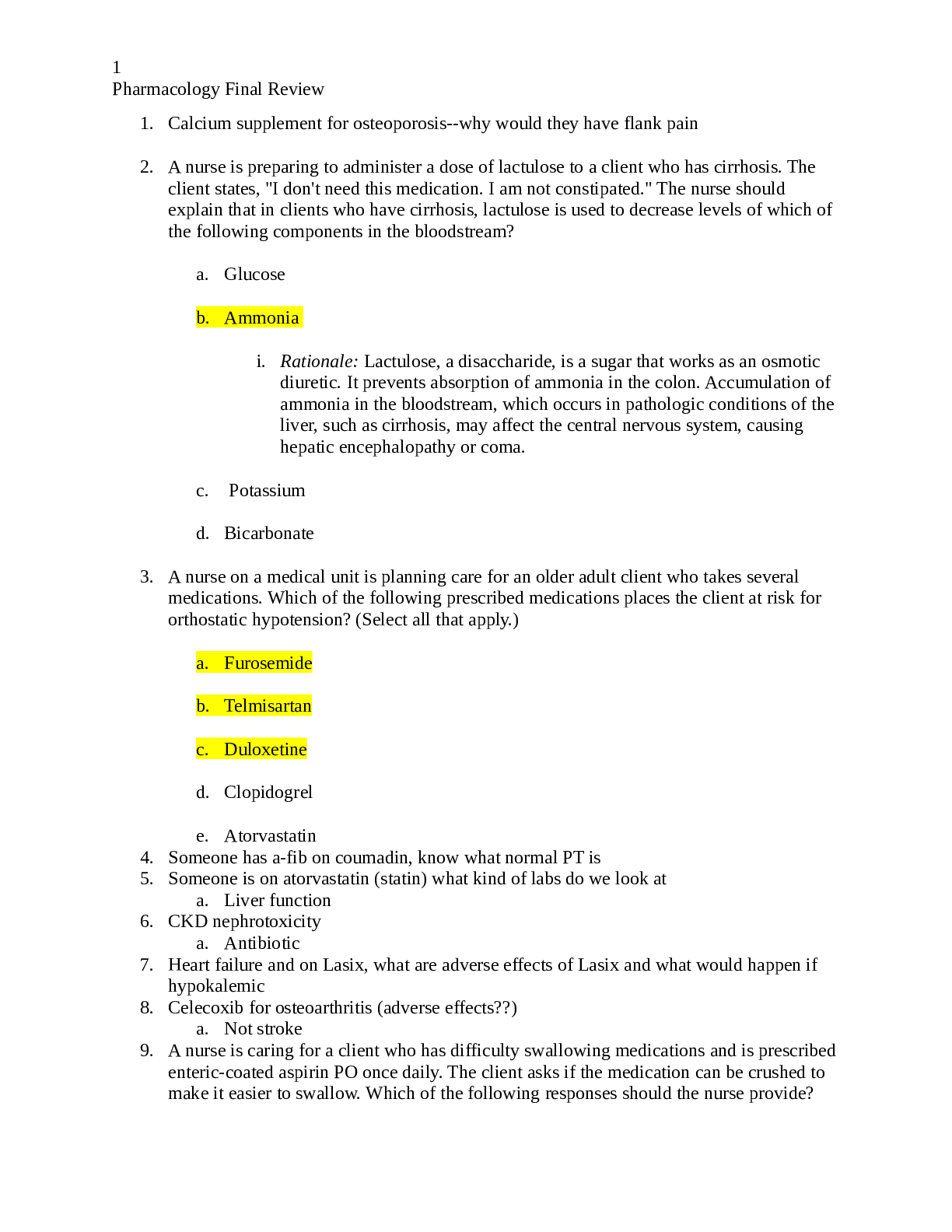

.png)
